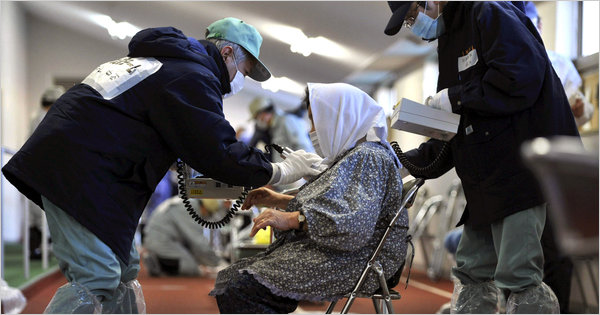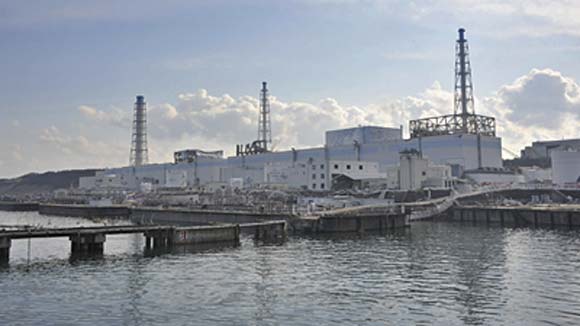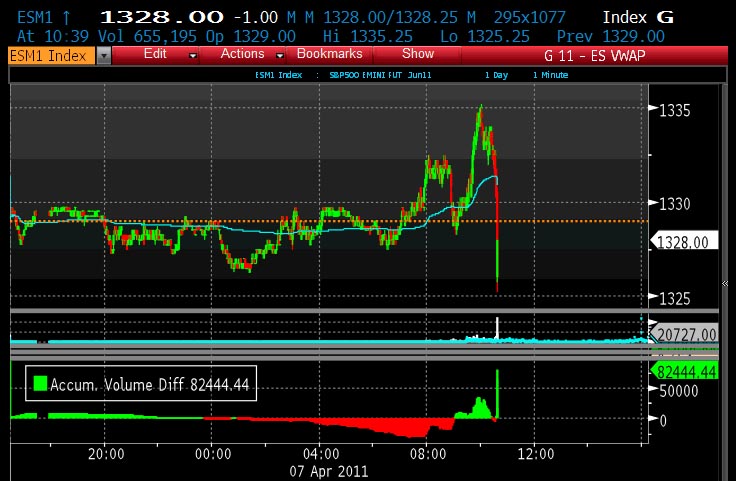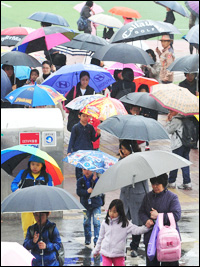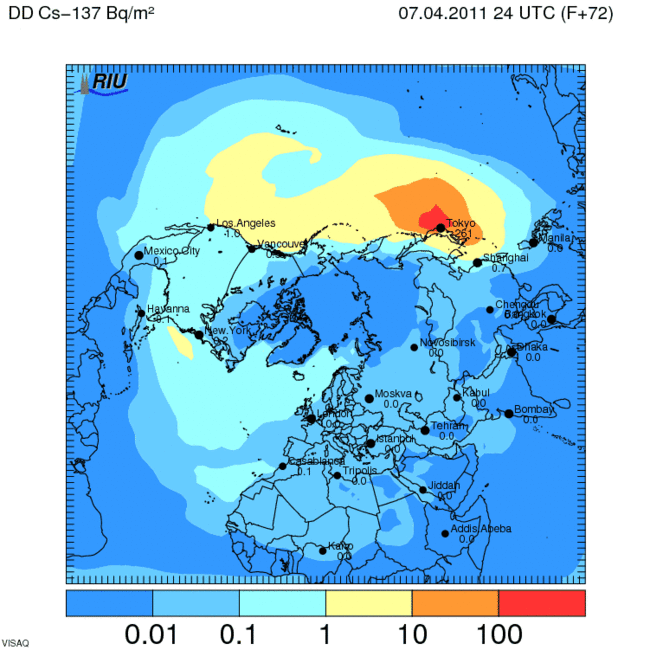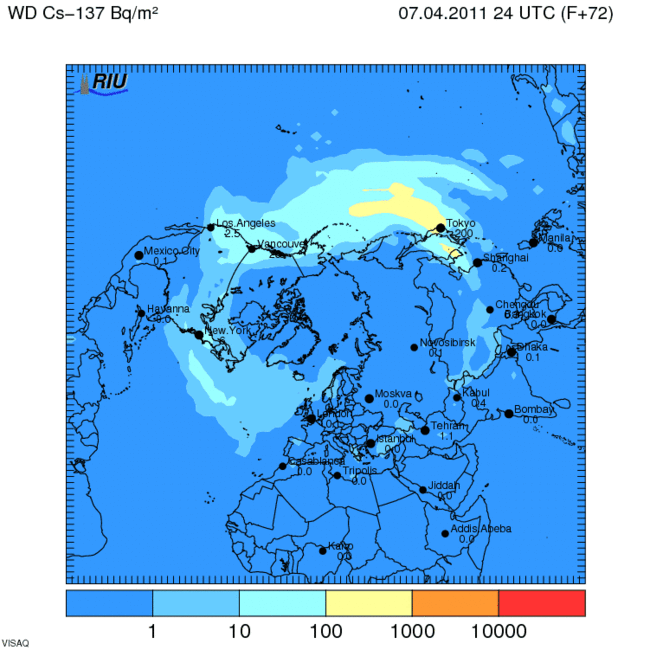The following are results for milk samples obtained from a Bay Area organic dairy where the farmers are encouraged to feed their cows local grass. We have detected I-131, at 0.70 Becquerels per liter and lower, as well as Cs-134 and Cs-137.
…
Because the “best by” date on milk is approximately 17-19 days after the milk has been bottled, our milk sample with a date of 3/25 represents milk bottled on approximately 3/5. Since this is before the Fukushima crisis, we do not expect to see any fission product radioisotopes and do not see any within our sensitivity. Our first sample of milk showing any signs of radioisotopes has a date of 4/4, which means it was bottled around 3/18. This is approximately when the trace radioactive isotopes were first seen in the Bay Area.
| I131 | I132 | Cs134 | Cs137 | Te132 | Data | |
|---|---|---|---|---|---|---|
| Best By Date | Bq/L (liters**) | Bq/L (liters**) | Bq/L (liters**) | Bq/L (liters**) | Bq/L (liters**) | |
| Estimated Minimum Detectable Activity (MDA) for samples ending 4/4 | 0.14 | 0.23 | 0.14 | 0.18 | 0.10 | |
| 3/25/2011 | less than MDA |
less than MDA |
less than MDA |
less than MDA |
less than MDA |
data |
| 4/4/2011 | 0.70 ± 0.27 (3,800) | less than MDA |
less than MDA |
less than MDA |
less than MDA |
data |
| Estimated Minimum Detectable Activity (MDA) for samples starting 4/8 | 0.04 | 0.05 | 0.03 | |||
| 4/8/2011 | less than MDA |
less than MDA |
less than MDA |
less than MDA |
less than MDA |
data |
| 4/11/2011 | 0.14 ± 0.08 (18,900) | less than MDA |
less than MDA |
less than MDA |
less than MDA |
data |
| 4/14/2011 | 0.10 ± 0.04 (26,300) | less than MDA |
0.11 ± 0.04 (22,100) | less than MDA |
less than MDA |
data |
| 4/16/2011 | 0.22 ± 0.04 (12,200) | less than MDA |
0.10 ± 0.04 (24,000) | 0.22 ± 0.08 (12,000) | less than MDA |
data |
** The number in parentheses is the number of liters of milk that one would need to consume to equal the radiation exposure of a single round trip flight from San Francisco to Washington D.C. (0.05 mSv). To see how we calculate these numbers, please visit our explanation of the equivalent dose calculation.
And again the general public is fed scientific bullshit, because like the MSM the University of California, Berkeley compares mice with elephants in the room!
You can’t compare radiation exposure with inhalation or ingestion of radioactive particles!
How come the Department of Nuclear Engineering at the UCB does not know these facts???
Radiation exposure is increased by a factor of a trillion. Inhaling even the tiniest particle, that’s the danger.
Yo: So making comparisons with X-rays and CT scans has no meaning. Because you can breathe in radioactive material.
Hirose: That’s right. When it enters your body, there’s no telling where it will go. The biggest danger is women, especially pregnant women, and little children. Now they’re talking about iodine and cesium, but that’s only part of it, they’re not using the proper detection instruments. What they call monitoring means only measuring the amount of radiation in the air. Their instruments don’t eat. What they measure has no connection with the amount of radioactive material.
According to the National Academy of Sciences, there are no safe doses of radiation. Decades of research show clearly that any dose of radiation increases an individual’s risk for the development of cancer.
“There is no safe level of radionuclide exposure, whether from food, water or other sources. Period,” said Jeff Patterson, DO, immediate past president of Physicians for Social Responsibility. “Exposure to radionuclides, such as iodine-131 and cesium-137, increases the incidence of cancer. For this reason, every effort must be taken to minimize the radionuclide content in food and water.”
– Updating Japan’s Nuclear Disaster:
“Nuclear radiation is forever,” she added. It doesn’t dissipate or disappear. Jeff Patterson, former Physicians for Social Responsibility president said, “There is no safe level of radionuclide exposure, whether from food, water or other sources. Period.” In 1953, Nobel laureate George Wald agreed saying “no amount of radiation is safe. Every dose is an overdose.”
About plutonium found around the Fukushima nuclear plant we were told that those ‘tiny’ levels of plutonium pose no ‘human health risk‘!!!
Think again:
“Plutonium is the deadliest substance on the planet since 1 molecule of Plutonium in your body guarantees the development of cancer, according to radiation medicine experts.”
– Dr. Rima Laibow
Response of the US government to the Fukushima nuclear crisis:
– US Gov Has Still Not Published Any Official Data On Japan Disaster
Europe seems to have the same disaster plan:
– EU Erhöht Grenzwerte Drastisch! EU Raises ‘Safe Level’ of Cesium in Japanese Food By 20 Times!
In Canada:
– Just In Time: Canada Suspends Mobile Radiation Measurements
– Canada Refuses To Test Milk For Radiation
“Nuclear radiation is forever,” she added. It doesn’t dissipate or disappear. Jeff Patterson, former Physicians for Social Responsibility president said, “There is no safe level of radionuclide exposure, whether from food, water or other sources. Period.” In 1953, Nobel laureate George Wald agreed saying “no amount of radiation is safe. Every dose is an overdose.”

